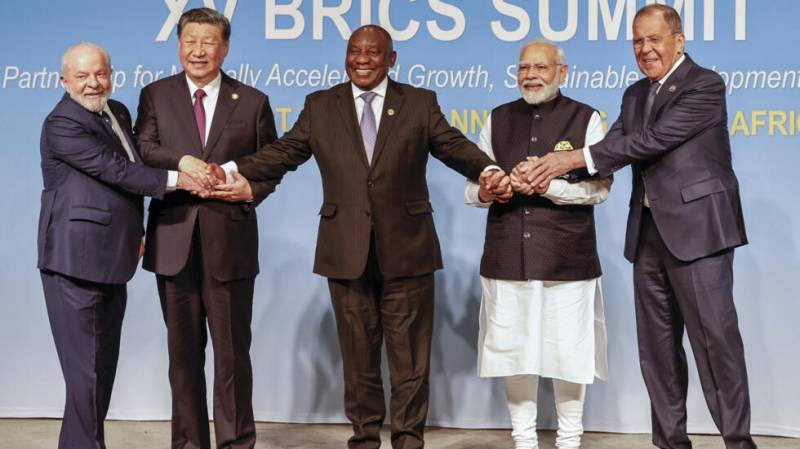
As the geopolitical tectonic plates shift, the expansion of BRICS (Brazil, Russia, India, China, and South Africa) heralds a pivotal moment in global politics. The inclusion of new members such as Saudi Arabia, Iran, the UAE, Argentina, and others marks a transition from a relatively insular economic bloc to a formidable coalition with aspirations to reshape the global order. This expansion, often termed as BRICS 2.0, reflects the growing ambitions of the Global South to challenge the hegemony of Western-led institutions and foster a multipolar world.
The Evolution of BRICS
Since its inception in 2009, BRICS has evolved from a loose grouping of emerging economies into a coordinated platform addressing economic, political, and developmental issues. Initially focused on economic cooperation, the bloc now seeks to amplify its geopolitical clout. The latest expansion signals an intent to create a counterbalance to the dominance of Western alliance’s such as the G7 and NATO. With an expanded membership, BRICS’ combined GDP and population surpass those of many traditional power blocs, underscoring its potential to recalibrate global dynamics.
A Multipolar Vision
The expansion aligns with the broader aspirations of the Global South to advocate for equitable global governance. For decades, developing nations have voiced concerns about their marginalisation in institutions such as the IMF and the World Bank. By bringing together countries that share grievances against the Western-centric system, BRICS 2.0 provides a platform for alternative narratives and solutions. For instance, the bloc’s push for de-dollarisation and the establishment of a BRICS currency could disrupt the global financial architecture, reducing reliance on the US dollar and enhancing financial sovereignty for member states.
Challenges to Western Hegemony
The West’s dominance in global institutions has long been a source of contention. BRICS 2.0’s growing influence presents a direct challenge to this status quo. The inclusion of energy giants like Saudi Arabia and Iran enhances the bloc’s leverage in global energy markets, while the addition of countries like Argentina expands its reach into Latin America. This diversification not only strengthens BRICS economically but also enhances its geopolitical influence, enabling it to act as a cohesive voice on critical issues such as climate change, trade disputes, and technological governance.
Western nations may need to rethink their strategies to engage with a more assertive Global South, recognising the importance of multilateral cooperation over unilateral dominance
Internal Divergences
Despite its growing strength, BRICS 2.0 faces significant internal challenges. Member states—both old and new—possess divergent political systems, economic priorities, and strategic interests. For instance, China and India’s border disputes, Russia’s strained relations with the West, and differing development levels among members could hinder consensus-building. Additionally, managing the expectations of an expanded membership while maintaining the bloc’s coherence will test its institutional capacity.
The Role of New Technologies
Technology is poised to play a critical role in BRICS 2.0’s vision for the future. Collaborative efforts in artificial intelligence, cybersecurity, and digital infrastructure could position the bloc as a global leader in technological innovation. By investing in digital connectivity and fostering partnerships in tech-driven sectors, BRICS can bridge developmental gaps and create opportunities for shared growth among its members.
Implications for the Global Order
The rise of BRICS 2.0 signals a shift towards a more multipolar world where the Global South asserts its agency. This development has profound implications for international relations, particularly in the realms of trade, energy, and security. Western nations may need to rethink their strategies to engage with a more assertive Global South, recognising the importance of multilateral cooperation over unilateral dominance.
Conclusion
BRICS 2.0 represents a pivotal moment in the global geopolitical landscape, signaling that the Global South is no longer passive in the shaping of the world order. The bloc’s expansion goes beyond a simple increase in membership; it is a strategic move towards establishing a more inclusive and multipolar world, where the voices of emerging economies are heard and their concerns are addressed. As BRICS embraces its new members, it affirms its collective will to challenge the dominance of traditional powers and to promote a more equitable global system, one that prioritises the development aspirations of the Global South. However, the path forward is not without its obstacles.
The internal diversity of BRICS, encompassing countries with varied political systems, economic interests, and regional priorities, presents a complex challenge in terms of fostering unity and coherence. Moreover, BRICS faces external pressures from entrenched global powers, who may seek to undermine its influence or sideline its initiatives. The bloc's ability to overcome these hurdles will be critical in determining its long-term impact on global governance. Despite these challenges, the increasing influence of BRICS is undeniable. The bloc's growing economic, political, and cultural clout demonstrates the shifting power dynamics and the movement towards a more balanced and multipolar global order. The future of BRICS will hinge on its ability to forge deeper cooperation among its members, build stronger alliances with other nations, and effectively challenge the status quo. As the 21st century unfolds, BRICS 2.0 will likely play a central role in shaping the contours of global governance, offering a counterbalance to traditional power structures and fostering a more diverse, collaborative, and just world order.

